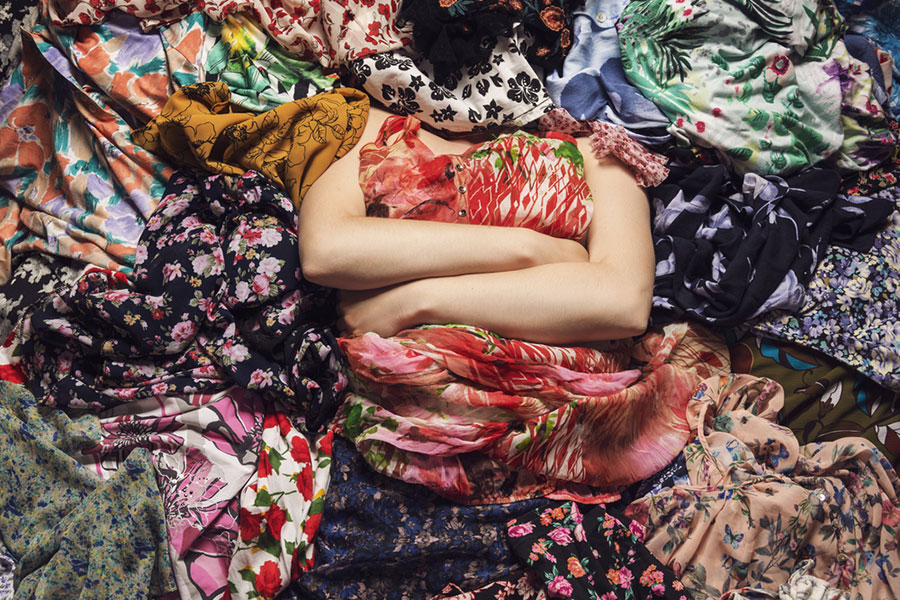
27 Oct Why Everyone Needs to Support Slow Fashion
Seventy-five percent of fashion supply chain materials end up in landfills, according to the Pulse of the Fashion Industry 2018 Report, which amounts to the equivalent of one garbage truck of textiles per second.
The environmental dangers of fast fashion are overwhelming and, as the world’s second most polluting industry, consumers need to start changing the way they think about fashion and following endless trends.
What is slow fashion?
Slow fashion is about consuming and creating fashion consciously and with integrity, connecting social and environmental awareness and responsibility with the joy of wearing beautifully made clothing that lasts.
Slow fashion encourages us to be intentional in our purchases so that we’re not buying that extra pair of jeans or silk blouse we don’t really need just because it’s on sale. The endorphins we experience when purchasing something are fun in the moment, but the long-term effects that our obsession with mindless consumerism has on the planet are utterly devastating.
How COVID-19 has changed our relationship with clothes
With more than 3.5 billion people in voluntary or mandatory confinement, 2020 has seen millions of people working from home and ditching their ‘work wardrobe’ in favour of sweats, T-shirts, and hoodies. If there’s one thing we’ve learnt during the COVID-19 pandemic, it’s that many of us can work from home and we can all live off less, especially when it comes to clothing.
Re-evaluating your relationship with fashion and the clothes you already have in your wardrobe to adopt the mentality of slow fashion is much simpler than you think.
Buy pre-loved clothing
Thrift stores have popped up around South Africa in recent years touting people’s pre-owned and -loved clothes, shoes, and accessories. Maven Sustainable sells pre-loved women’s and childrenswear and supports local charity organisation The Clothing Bank by donating an item of clothing for every item sold on their site, while WORN thoughtfully selects timeless pieces to offer conscious alternatives to fast fashion at more affordable prices.
Capetonians can visit Resale Therapy Boutique for beautiful thrifted clothing, while conscious consumers in Jozi can find gently worn designer clothes, shoes, and bags at Huntress.
Read the label
If you’re concerned about the environmental impact of fashion, spend some time reading your garment tags to find out what fabric your clothes are made from. Choose clothing made from sustainable and environmentally friendly fabrics such as hemp, organic cotton, Tencel, or reused, upcycled and recycled materials that are coloured using natural dyes.
Ask yourself who is making your clothing and accessories and how they are treated. To ensure you’re contributing towards people’s livelihoods and supporting ecologically friendly materials and business practices, do some homework to find out which retailers are naughty or nice to ensure you’re making sustainable fashion choices.
Wash less
Where you can, wear your clothes more than once before throwing them in the laundry basket. Washing clothes is extremely draining on water and energy resources and delaying the extra wash will be better for your clothes and the planet. When laundry day eventually does roll around, use eco-friendly detergent and air dry your clothing outside rather than putting it in the dryer.
Donate your old clothes
Commit to clearing out your wardrobe at least twice a year to decide what you will keep, revamp, swap with a friend, or donate to second hand stores. It’s a great way to pay your fashion choices forward and make someone else’s wardrobe.
Retailer H&M has started a conscious collection with clothing made from materials such as recycled polyester, Tencel, and organic cotton, while Zara also has donation bins at selected stores around South Africa where customers can donate pre-loved clothes, which will be distributed to non-profit organisations around the country to give them a second life.
By taking these small steps, we can slowly begin to change our relationship with clothing and contribute towards a more sustainable fashion industry for the good of the planet and everyone on it.



No Comments